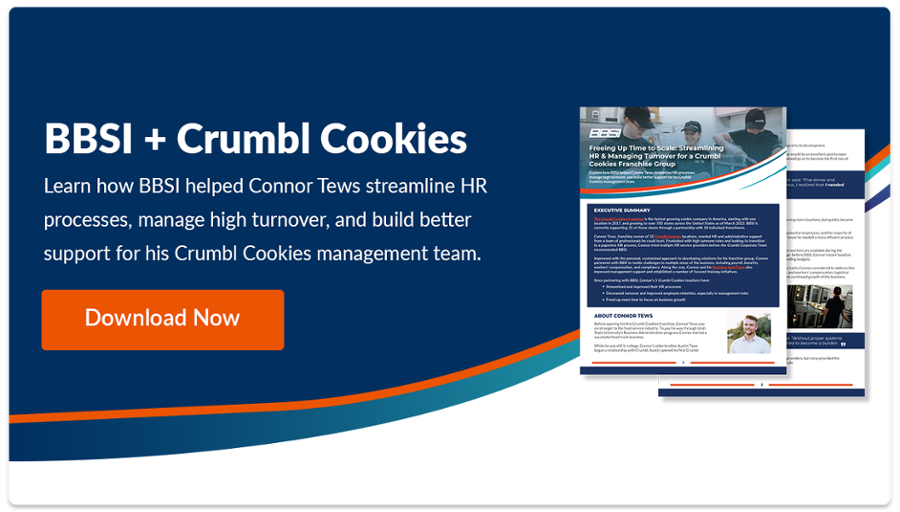
How to Create a Growth Plan for Your Small Business
Did you know roughly half of small businesses fail within their first five years? Only 30% make it past their first decade. To succeed as a small business, you must look ahead and take advantage of growth opportunities. This is where a business growth plan can come in handy.
Business growth plans are roadmaps that help business owners anticipate worthwhile opportunities and prepare for upcoming obstacles.
We recently discussed strategic growth plans for small businesses with Rob Hambleton, our Southern Oregon Area Manager, in an episode of our BBSI Entrepre(doers) podcast. Given his extensive experience in the small business sphere, we wanted to get his thoughts on what growth plans are, what makes one effective, and how small business owners can craft and implement their own.
Listen to the BBSI Entrepre(doers) Podcast
Robert Hambleton, BBSI Southern Oregon Area Manager, joins the show to discuss creating a growth plan for your small business. Robert shares key industry indicators and metrics to measure success, the advantage of incorporating SMART goals, best practices to track or evaluate performance, and more. You'll learn how to identify growth opportunities within your small business so you can start planning for and managing your growth today!
The Importance of a Strategic Growth Plan for Small Businesses
As a small business owner, your day-to-day work may keep you so busy that you don’t have time to map out the future. Even so, it’s important to carve out a chunk of your time to look ahead and develop a strategic vision for your company. Let’s take a look into how a high-quality growth plan can enhance your small business:
- Direction: A business growth plan can serve as a compass for your company, clarifying your short-term and long-term goals and strategies for reaching them at every stage. It can help you focus your resources, time, and attention on the most fruitful initiatives.
- Risk mitigation: Growing a business always involves certain risks. By mapping out these risks in your growth plan, you can tackle them effectively and ensure they don’t derail your operations.
- Adaptability: As market factors and customer demands change, so must your small business. A growth plan can ensure your company is agile enough to thrive through evolving market conditions.
- Competitive advantage: A business growth plan can help you differentiate your company now and in the future, securing your competitive advantage.
- Financial stability: Sustaining a small business requires financial stability, from cash to capital. A growth plan can help you secure the financial resources you need to stay in business as you expand.
- Investor approval: Speaking of finances, you may need investors to finance your growth. A small business growth plan can help you attract their attention and convince them that a solid return on investment awaits them on the other side.
- Performance monitoring: By regularly checking in with your growth plan, you can see whether or not you’re meeting your goals and adjust your tactics accordingly.
Considering these benefits, a strategic growth plan can boost your small business's chances of lasting success.
The Critical Role of Cash Flow in Small Business Growth Plans
One important consideration when constructing a business growth plan is cash flow. With adequate cash flow, you may be able to afford the materials, equipment, and acquisitions required to scale up. Cash flow issues are one of the leading causes of small business failure.
You can prevent burning through your cash and credit by clearly mapping out how cash flows through your business. After, use financial forecasting to determine how different growth scenarios may impact your P&L and balance sheets.
Once you’ve clarified these aspects, you can pinpoint the optimal methods for collecting client payments. For instance, if you operate in a capital-intensive industry, such as construction or manufacturing, you may need to collect payment from clients well in advance. This way, you’ll have enough financial resources to finance your growth.
How to Identify Small Business Growth Opportunities
After fortifying your finances, it’s time to identify the most potent growth opportunities. Here are a few suggestions:
- Conduct market research to see where potential opportunities exist
- Consider targeting up-and-coming market sectors
- Add new products or services that align with your existing expertise
- Analyze your products, services, and mission statement to pinpoint areas for diversification
You can also uncover new opportunities by enlisting a fresh pair of eyes. For instance, here at BBSI, we frequently help small businesses carve out new niches as they pursue expansion.

Leverage SWOT Analysis and SMART Goals
Some other tools that can come in handy as you seek out growth opportunities include SWOT analysis and SMART goals:
- SWOT Analysis: SWOT stands for strengths, weaknesses, opportunities, and threats. A SWOT analysis can help you understand your current business situation, potential opportunities, and any risks that may lie ahead.
- SMART Goals: SMART stands for specific, measurable, achievable, relevant, and time-bound. Pursuing goals that meet these criteria can help you take realistic steps toward growing your small business steadily over time.
Together, these tools can give you a clear picture of your business prospects and inform your growth plan.
How Often Should You Update Your Growth Plan?
Over time, you’ll need to update your growth plan and forecast your goals further into the future. Some general guidelines for setting your growth plan review cadence are as follows:
- Once a month: If you have ambitious growth goals or urgent action items on the docket, you should check in with your growth plan at least once a month.
- Once a quarter: Quarterly growth plan reviews should be sufficient for most other scenarios.
- Once a major change within your business occurs: Change happens; if your business has experienced a major change (expansion, change of ownership, product or service additions, etc.), you should update your growth plan.
What Does Checking Your Growth Plan Look Like?
Checking your growth plan involves comprehensively evaluating your progress, aligning with stakeholders, reviewing goals, and setting new objectives. Here's an overview of this process:
Evaluation of Current Performance:
- Assess your business's performance against the goals and milestones outlined in your growth plan.
- Analyze key metrics, financial data, sales figures, customer feedback, and other relevant performance indicators.
- Identify areas of success and areas that require improvement.
Stakeholder Meetings:
- Schedule meetings with key stakeholders, such as business partners, investors, managers, and department heads.
- Share the findings from the evaluation and gather their perspective on the business's growth trajectory.
- Discuss challenges, opportunities, and any changes in the market or industry landscape.
Review of Goals:
- Review the goals established in your growth plan.
- Determine if they are relevant and aligned with the business's vision and objectives.
- Assess whether adjustments or modifications are necessary based on the insights gathered from the evaluation and stakeholder discussions.
Setting New Goals:
- Based on the evaluation, stakeholder input, and analysis, set new goals and objectives for your business.
- Ensure these goals are specific, measurable, attainable, relevant, and time-bound (SMART goals).
- Align them with your business's overall strategy and vision, considering market dynamics, financial considerations, and available resources.
You can always adjust your growth plan review frequency, ramping it up or down as needed. The right cadence depends on your urgency, time availability, and motivation.
The Value of a Growth Plan Consultant
Enacting and monitoring a growth plan as a small business owner can feel like a tall order. After all, you have a lot of other things on your plate. Fortunately, a growth plan consultant may be able to help. A growth plan consultant, like BBSI, is an experienced support system you can partner with to help with the following:
- Ensure growth plan relevance: As your goals and market conditions change, you may need to update aspects of your growth plan to ensure they’re still relevant. A consultant can initiate this process and suggest growth plan adjustments as needed.
- Facilitate team alignment: Aligning your team with your growth plan is imperative to its implementation. A consultant can help you engage your employees, obtain their buy-in, and train them effectively. They can also help ensure your growth plan’s goals align with your company’s mission, vision, and core values.
- Review results: Lastly, a consultant can evaluate your growth plan’s performance and identify why you may or may not have achieved your goals. If you need help time-blocking or updating your tactics, a consultant can guide you every step of the way.
As Rob Hambleton discussed in the podcast, BBSI takes a collaborative approach to consulting. He says it's more than building a consulting report, handing it over to the client, and expecting them to execute it. BBSI consultants walk you through the process. They support you every step of the way, from analyzing the situation, brainstorming the proper growth strategy, evaluating its efficacy in real-time, and adjusting if needed.
Supercharge Your Small Business Growth With BBSI
The right strategic growth plan for your small business can be the difference between achieving lasting success and becoming another statistic. Since every small business is different, there’s no one-size-fits-all growth plan you can employ. As a result, every small business owner must construct a custom growth plan tailored to their industry, vision, values, and goals.
If you need help with that process, BBSI is here to help. In addition to our payroll, workers’ compensation, benefits, HR, and risk mitigation services, we provide hands-on growth plan consulting. With our cross-industry experience, we can share our game-changing growth insights with your small business and bring your growth plan to life.
As Martin Luther King, Jr. said, “You don’t have to see the whole staircase; just take the first step.”
Take the first step today by partnering with BBSI.
Disclaimer: The contents of this white-paper/blog have been prepared for educational and information purposes only. Reference to any specific product, service, or company does not constitute or imply its endorsement, recommendation, or favoring by BBSI. This white-paper/blog may include links to external websites which are owned and operated by third parties with no affiliation to BBSI. BBSI does not endorse the content or operators of any linked websites, and does not guarantee the accuracy of information on external websites, nor is it responsible for reliance on such information. The content of this white-paper/blog does not provide legal advice or legal opinions on any specific matters. Transmission of this information is not intended to create, and receipt does not constitute, a lawyer-client relationship between BBSI, the author(s), or the publishers and you. You should not act or refrain from acting on any legal matter based on the content without seeking professional counsel.

